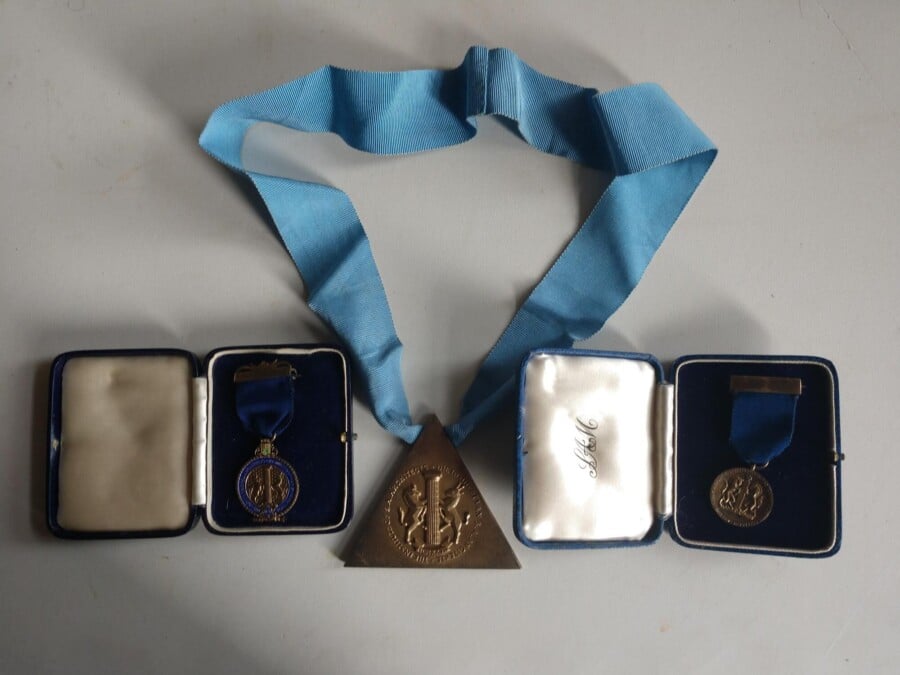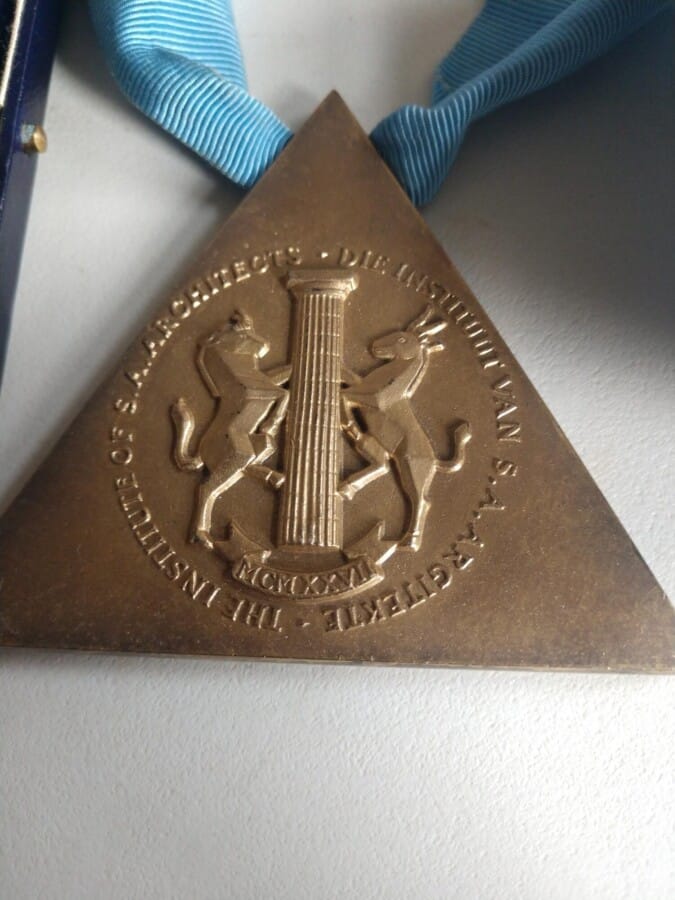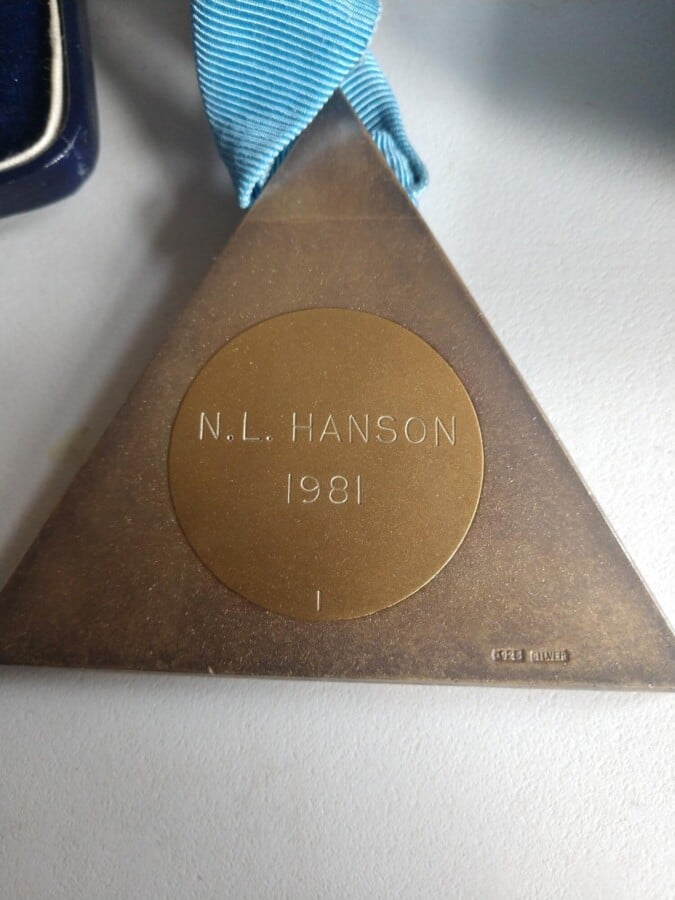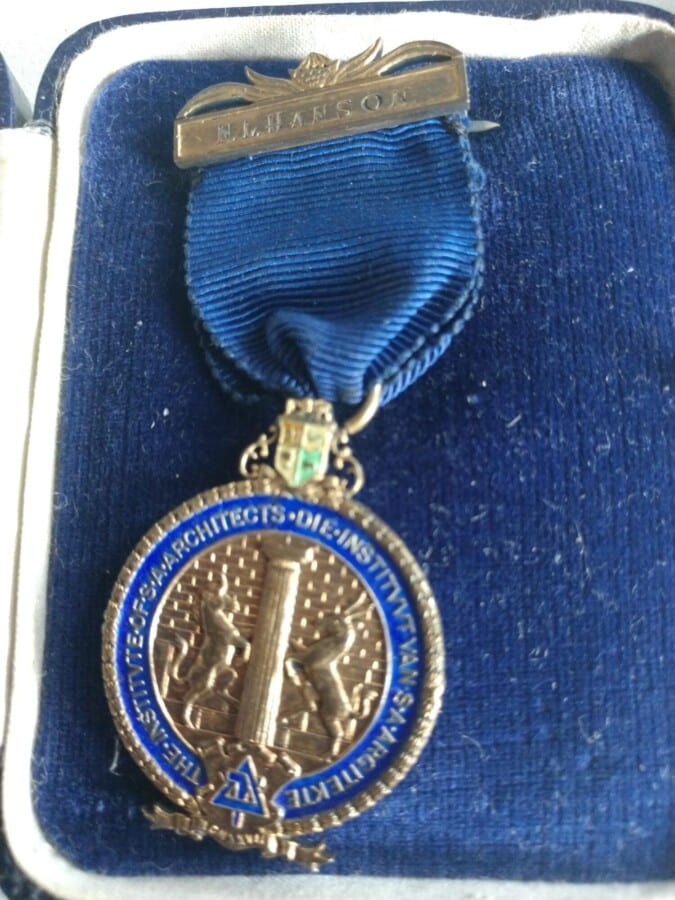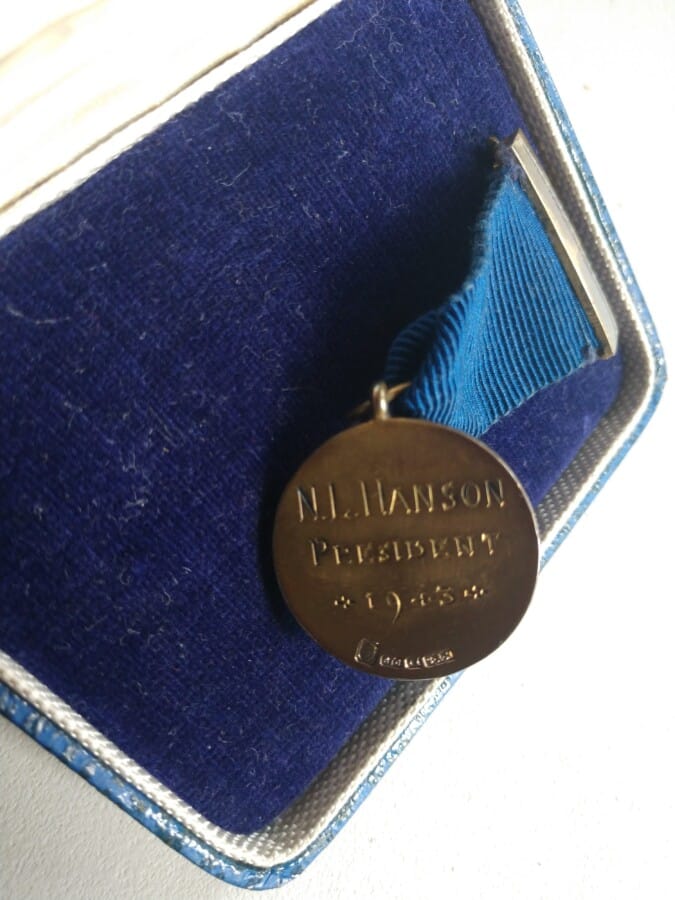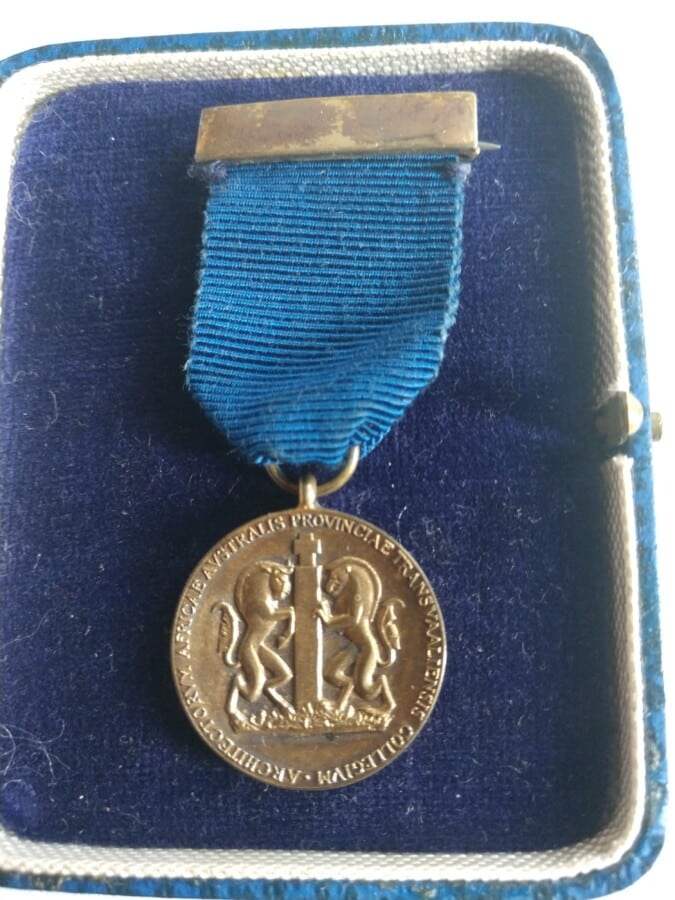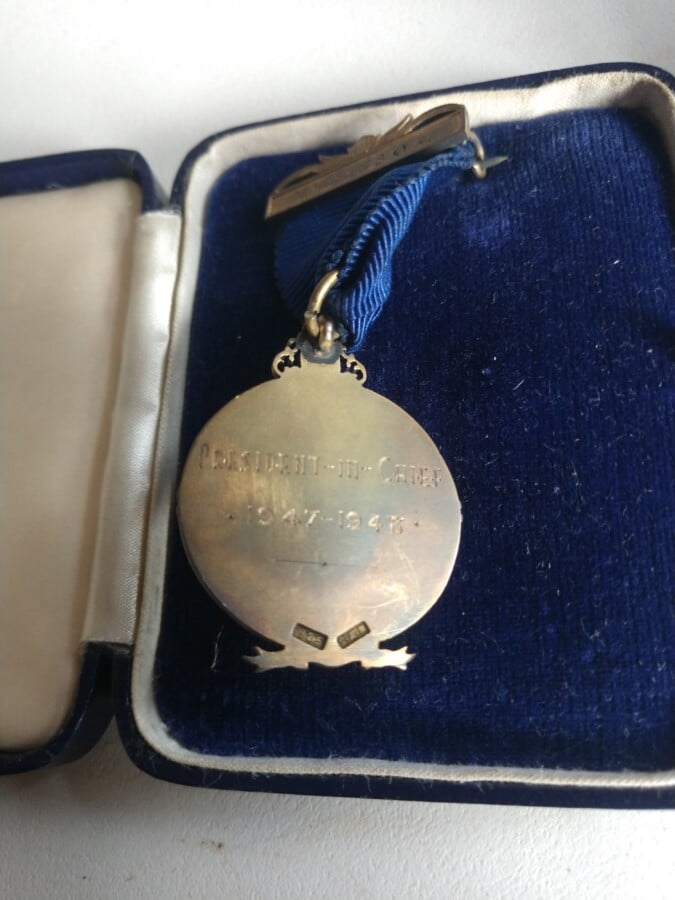Description
Unique set of silver medals awarded to Professor N L Hanson South African Architect Manchester
We are pleased to offer this unique set of 9ct gold on sterling silver medals that were awarded to a leading post war architect N L Hanson.
Full details of Norman Leonard Hanson’s amazing career can be found below.
Please note that a SINGLE medal awarded to N L Hanson in 1957 sold recently (2021) in the UK for £2,500 including fees (full details available on request).
However, that medal was NOT for one of his Presidential positions in the Institute and we are offering TWO of his Presidential medals.
Furthermore, the one that was sold at auction for £2,500 did not have it’s original box.
Hanson was born in Johannesburg in 1909 and attended King Edward VII School there.
His award winning work led to him being elected President of the Transvaal Provincial Institute of Architects (1943) and was President-in-Chief of Institute of South African Architects in 1947-1948.
The medals being offered here are Hanson’s:-
(1) 1943 “President” medal with his name on the reverse of the badge and the coat of arms of the Institute on the front in it;s original box.
This is a beautifully struck medal with deep relief on the front.
It has the original dark blue ribbon and an unmarked bar as the inscription is on the rear.
It has a diameter of 25mm and weighs 15g
Fully hallmarked for South African sterling silver.
(2) 1947-1948 “President-in-Chief” medal with “N L Hanson” on the bar and “President-in-Chief” engraved on the reverse with “1947-1948” and hallmarks for sterling silver.
This is an exquisite medal with wonderful enamelling on the 9ct gold plated sterling silver medal. The amount of detail on the front is amazing with a tiny enamelled quartered heraldic shield at the top, the superb central section with two springbok leaning on a pillar with a wall in the background, a blue enamelled section around the outer edge and then a monogram of a letter “T” coupled with a triangle at the bottom. At the very bottom are Roman numerals for 1928 when the Institute was established.
In it’s original box complete with dark blue original ribbon.
This medal weighs 15g and has a diameter of 30mm
(3) 1981 An absolutely amazing large, heavy triangular 9ct gold on sterling silver medal with a wonderful relief cast design of the Institute of S A Architects logo on the front and an inset plaque on the rear which reads “N. L. Hanson 1981”.
With it’s original light blue ribbon, this must have been awarded on an important occasion.
It could have been on his retirement or for a lifetime achievement as he was around 70 years of age in 1981.
This unique medal measures 75mm x 75mm and weighs a solid 155g.
Hanson was part of a team that designed the Humanities Building at the University of Manchester. Originally the Architecture & Planning Building, this grey concrete building was opened in 1970. Inside, there is a courtyard. The University’s website indicates that today the building is home to among others: the Architecture and Planning Department, the Brookes World Poverty Institute, the Cathie Marsh Centre for Census and Survey Research, the Cordingley Lecture Theatre, the Kantorowich Library, the Media Centre, and the Staff Training and Development Unit.
The following is courtesy of “Artefacts of South Africa”
Norman Hanson was born in Johannesburg and educated at King Edward VII School in Johannesburg from where he matriculated in 1924. He studied Architecture at the University of the Witwatersrand from 1925 until 1931 under Professor PEARSE and AS FURNER. At the University he was a contemporary of RD MARTIENSSEN who shared Hanson’s interest in modern European architecture and together they toured the Cape measuring historic buildings there as part of a student team under the guidance of Professor Pearse in 1927. As a student he was also a member of the Alpha Club. For six months (1929-1930) he toured Europe, visiting England, France, Italy, Germany and Holland and in 1932 he graduated, entering into partnership in Johannesburg in April 1932 with SN TOMKIN and NI FINKELSTEIN (cf HANSON, TOMKIN & FINKELSTEIN).
Hanson’s career between 1932 and 1939 coincided with an important period in the growth of South African architecture; he belonged to a group of young architects, christened the Groupe Transvaal by Le Corbusier and adopted by their leader Rex Martienssen, at the University of the Witwatersrand who were influenced by the work of European architects, in particular LE CORBUSIER and Mies van der Rohe. Their progressive concepts and published designs provoked lively criticism and introduced Johannesburg to new ideas in building. Hanson put these new ideas into practice and among his early works reflecting contemporary European architectural thinking was Hotpoint House (1934) in Johannesburg, Hanson’s own favourite work. Here he maintained an intimate scale, crisp modelling, the ten extruding balconies provided the building with texture and tension.
Herbert (1975:137) points out that the building ‘was the first major South African building authentically in the modern idiom to appear in the pages of any South African publication’. The period culminated in the building of the 20th Century Cinema in Johannesburg (1940). Professor GUEDES‘ comment ‘Norman Hanson’s early works have a mad poetry, a luminous clarity and a conviction without parallel amongst the second generation of Modernists here or anywhere else in the world’ (Arch SA May/June 1987: 17) effectively sums up the impact of Hanson’s early work.
Rebuilding his practice after the Second World War, Hanson reappraised the theories of Le Corbusier and found himself more in sympathy with ‘architects and constructors such as Perret and Nervi’ (Contemporary Architects 1980:341). In 1943 he was elected President of the Transvaal Provincial Institute of Architects and was President-in-Chief of Institute of South African Architects in 1947-1948, a member of the Board of the Faculty of Architecture at the University of the Witwatersrand, an executive member of the National Housing and Planning Commission and a founder member of the Building Research Advisory Committee of the National Building Research Institute (NBRI), a founder member of the Management Committee of the National Development Fund for the Building Industry and a member of the Board of Education of the ISAA of which he was also chairman from 1946 to 1963.
Hanson was also development consultant for the new town of Ashkalon in Israel from 1949 to 1961. He married in 1961 and was visiting Professor at the University of New South Wales, Australia in 1962. He became Professor and Director of the Architecture School, Manchester University, England, in 1961 and was Professor Emeritus of this school from 1971.
He was in partnership with Roy KANTOROWICH with whom he designed the ‘Kantorowich Building’ (1970) at the University of Manchester, England (cf HANSON, KANTOROWICH & PARTNERS).
The Norman L Hanson Scholarship was founded in recognition of his services to the ISAA and to the Building Industry by the Federation of Building Trade Employers, the NBRI and ISAA jointly.
Mem TPIA 1932; ISAA 1932; ARIBA 1935. (ARIBA nom papers (1935) 5842; AD Jun 1956; Arch Rev Jun 1953:363, 407; Arch SA May/Jun 1987:17-21; Contemporary Archts 1980; Herbert 1975; Hanson 1985; SAAR Nov 1941; SAAR Jul 1959:19; SAAR Feb 1965; SAAR Apr 1965 suppl)
Publ: The metaphysics of space, SAAR Sep 1932:246-47; Reply to Modern Methods, SAAR Apr 1936:109-11; Architecture of the new aesthetic, SAAR Nov 1936:375-79; Letter SAAR Sep 1937:430; House in Brooklyn, Pretoria, SAAR May 1938:141-49; The business centre of Cape Town, SAAR Sep 1938:356-72; An architect’s house, SAAR Oct 1939; The Baker Scholarship 1939, SAAR Mar 1940:69-83; Meadowbrook: an essay in domestic architecture, SAA&E Jan 1936:2-7; 20th Century Cinema, Johannesburg, SAAR Aug 1940; Letter on the Le Corbusier controversy, SAAR Oct 1942:291-97; In memoriam RD MARTIENSSEN, SAAR Nov 1942; South Africa – architecture from 1700-1930, Arch Rev Oct 1944
Recipient of the Gold Medal Award and the Medal of Distinction from the South African Institute of Architects.
All truncated references not fully cited in ‘References’ are those of Joanna Walker’s original text and cited in full in the ‘Bibliography‘ entry of the Lexicon.
Books citing HANSON
|
Beck, Haig (Editor). 1985. UIA International Architect : Southern Africa (Issue 8). London: International Architect. pp 59 |
|
Chipkin, Clive M. 1993. Johannesburg Style – Architecture & Society 1880s – 1960s. Cape Town: David Phillip. pp 246 |
|
Emanuel, Muriel. 1980. Contemporary architects. London: Macmillan. pp 339-341 |
|
Greig, Doreen. 1971. A Guide to Architecture in South Africa. Cape Town: Howard Timmins. pp 63 |
|
Herbert, Gilbert. 1975. Martienssen & the international style: The modern movement in South African architecture. Cape Town – Rotterdam: AA Balkema. pp 32, 37, 39, 41, 44, 48, 49, 50, 51, 53, 63, 66, 71, 72, 73, 76, 78, 83, 86, 87, 88, 89, 93, 94, 96, 97, 107, 108, 114, 129, 133, 136-140, 141, 143, 144, 145, 149, 150, 154, 158, 162, 163, 168, 170, 171, 176, 180, 182, 184, 185, 186, 187, 188, 196, 19 |
|
ISAA. 1959. The Yearbook of the Institute of South African Architects and Chapter of SA Quantity Surveyors 1958-1959 : Die Jaarboek van die Instituut van Suid-Afrikaanse Argitekte en Tak van Suid-Afrikaanse Bourekenaars 1958-1959. Johannesburg: ISAA. pp 91, 185 |
|
ISAA. 1969. The Yearbook of the Institute of South African Architects and Chapter of SA Quantity Surveyors 1968-1969 : Die Jaarboek van die Instituut van Suid-Afrikaanse Argitekte en Tak van Suid-Afrikaanse Bourekenaars 1968-1969. Johannesburg: ISAA. pp 94, 119 |
|
Morgan, Ann Lee & Naylor, Colin. 1987 [1980]. Contemporary Architects. Chicago and London: St. James Press. pp 380-382 |

